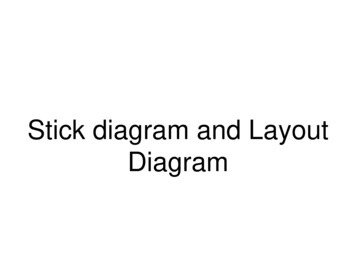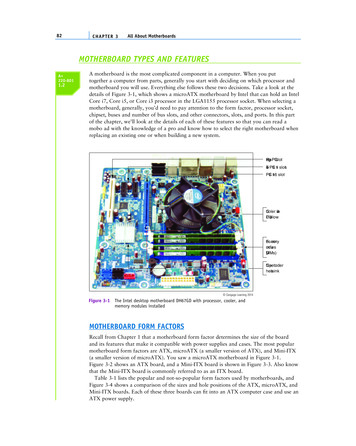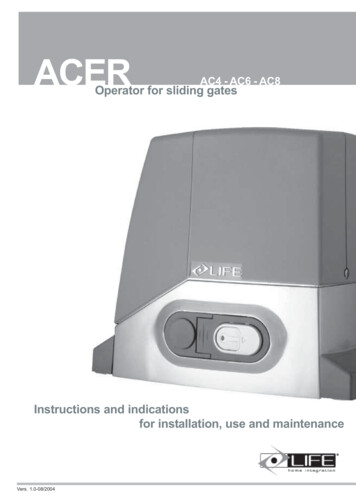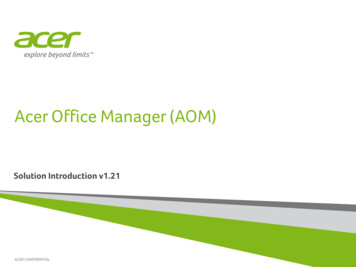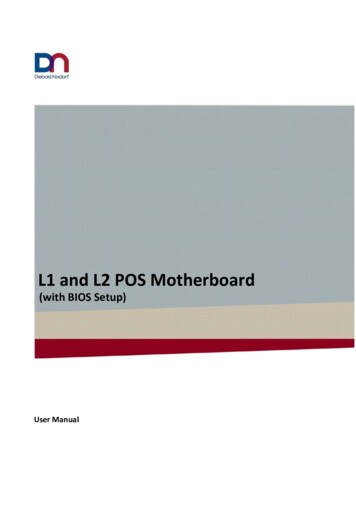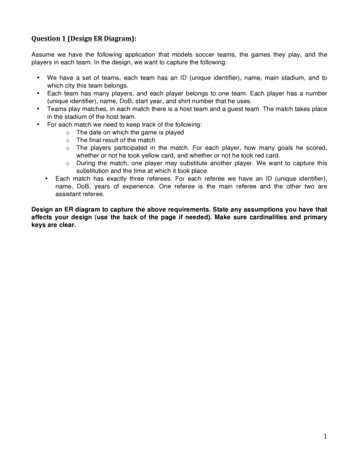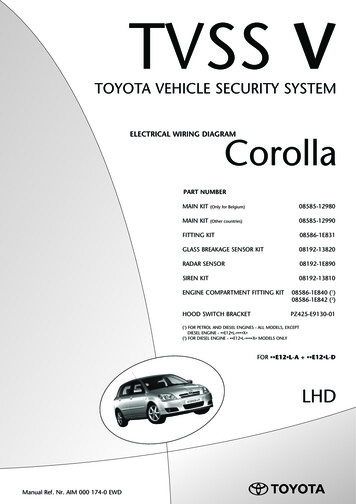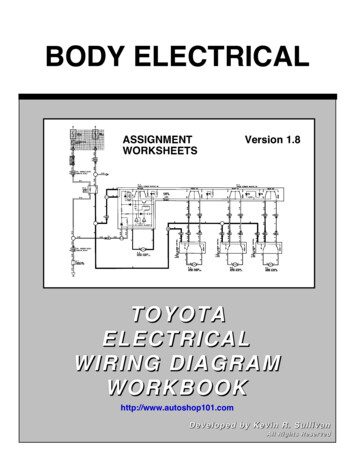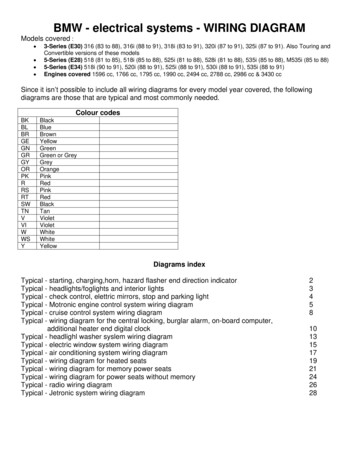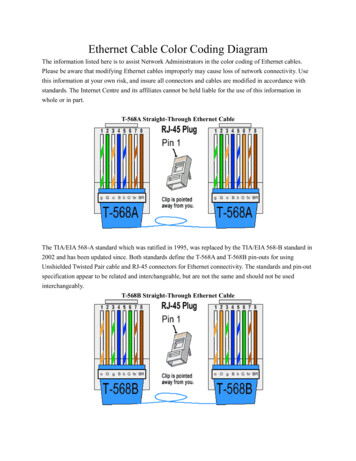
Transcription
Motherboard and its ComponentsLabeled diagram of Acer motherboard.Introduction to the motherboardYou may choose to click on the images to the right and explore whatamotherboard looks like in more detail, but our primary emphasis is just what itdoes. Besides, motherboards do not all look alike. (Compare to image below.) It's abit like lifting the hood on your car. You don't have to be a mechanic to know whereto add windshield washer fluid. One of my goals is simply to take the mystery out ofall that "stuff". It would be useful to open an old desktop PC just to actually see theparts. While I don't recommend this with a laptop or hand-held device, the conceptsare pretty much the same. That goes for servers, mainframes and supercomputers, aswell.We will talk about a few things you might do yourself to upgrade your computer inthe last section of this module. Simply looking inside your computer can tell you ifyou have an open bay to add another hard disk and if you can add memory (or haveto replace it).A motherboard is an electronic circuit board in a computer which interconnectshardware devices attached to it — which is to say, all of the system hardware. At aminimum it includes one or more Central Processing Units (CPU), and the mainprocessing activity of the computer takes place on it. However, other connectedprinted circuit boards may contain their own pre-processing or post-processingCPUs, to take some of the load off of the motherboard; these, together with other
plug-in boards without CPUs, may be called "daughter boards". It was called a"mother" board in relation to these. A PC motherboard generally has a series ofslots, allowing daughter boards to be plugged in directly. Other connectors on themotherboard allow communication through cables with various peripheral devices,both inside and outside the computer case.ATX motherboard legend1. Processor socket2. Chipset3. RAM slots4.AGP graphic cardslot5. PCI slots6. CNR modem slot7. Audio chip8. I/O chip9. BIOS10. ATX power connector11.Floppydriveconnector12. ATA tc.The external ports (connections)are along the top edge (right handside). A face-on view is shownbelow.motherboardoardwhat isamotherbmotherboardbasicsRecommended!(despite the lousy sound track)PortsPorts are used by a motherboard to interface with electronics both inside and outside of the computer. Integrated ports arethose that are part of, directly wired to, the motherboard. Internal integrated ports are used to connect devices inside thesystem unit. Externalports may be connected to the motherboard directly (integrated) or by circuit boards that are insertedinto slots on the motherboard. It is often possible to add new external ports by inserting such a circuit board into an openslot. The external integrated ports are generally grouped together as shown below. Expansion card ports are arranged in arow of equal sized rectangular slots (see graphics/video and network cards below).
Typical integrated motherboard ports (see top view above) — public domain image1. & 2. PS/2 (mouse, keyboard) 3. RJ-45 Ethernet 4. USB6. parallel (printer)7. VGA monitor5. Serial (terminal, modem)8. DA-15 (old networking) 9. audioPS/2PS/2 ports were for connecting peripherals such as your mouse (1 above) andkeyboard (2 above) to the computer, but are now outdated. PS/2 based mice andkeyboards have now been replaced by USB ports as the popular standard. This trendfor USB over PS/2 started in circa 2004.PS/2connectorBy Piotrek91 (Camera OlympusCamedia 480Z) [CC-BY-SA-2.5RJ-45Wired Ethernet connection (3 above). Looks like a (bigger) telephone/modem jack.The cable itself is referred to by its category (e.g. CAT 5) and basic type, UTP(UnshieldedTwistedPair).public domain imageEthernetcable
USBUSB (4 above), or Universal Serial Bus, is a connectivity specification, currently atversion 3 (V3). They are very common today, connecting flash drives and manyperipherals. Modern desktop systems have should have 4-8 on the back of thecomputer and at least two on the front.USB is one of the most successful interconnect in computing history. V1 operates at1.5 Mbps (low speed) or 12 Mbps (full speed), V2 (high speed) at 480 Mbps, andV3 (super speed) at up to 5Gbps. It can be found in over 2 billion PC and mobiledevices. USB has strong consumer brand recognition and a reputation for ease-ofuse.USB connectors are sometimes used to supply power, generally to recharge handheld devices like a smartphone.Different USB connectors. From left to right: male Micro USBB-Type, proprietary (not USB), male Mini USB (5-pin) B-type,female A-type, male A-type, male B-type. Shown with acentimeter ruler. Female A-type connector (4th from left) is"upsidedown"toshowthepins.USBconnectortypesBy Viljo Viitanen (Own work) [Public domain], via WikimediaBy derivative work: Darx (talk)Types-usb.svg: BrunoCommonsDuy (Types-usb.svg) [GFDL or CC-BY-SA-3.0], viaWikimedia CommonsWhat is a Computer Bus?A computer bus carries data from one device to another. It's more like an electricitybus than the vehicle. In terms of vehicles, the (computer) bus would be the roadbeing traveled, with the vehicles on the road being the data. Serial bussesallow onevehicle at a time, while parallel busses support multiple vehicles. Modern serialbusses are faster because the data (vehicles) travel at a greater speed.ComputerByPaulimagebusanalogyMullins: constructed
SerialAn outdated piece of technology, serial ports (5 above) were most often used toconnect the mouse and keyboard. By circa 2000, most personal computers stoppedrelying on serial ports and were replaced by PS/2 and/or USB ports.SerialconnectorBy David Marsh (Flickr: SerialCable)[CC-BY-2.0], viaWikimedia CommonsParallelParallel ports (6 above) are used to connect other peripherals such as joysticks, andmore commonly, printers. Similar to the serial port, this technology is slowly beingphased out in favor of USB. Parallel ports can still be found in many motherboardstoday.Parallel printerdomain imagecable — publicVGAA VGA (7 above), or Video Graphics Array, connector is used to connect a monitoror other video equipment. The same connector is sometimes used for high definitiontelevision and is sometimes called an RGB connector.DA-15The DA-15 port shown (8 above) has been used for network connectivity and forvideo output.VGA cable for monitor — publicdomain imageAudioThe audio input and stereo output ports (9 above) connect to external speakers, amicrophone, head sets, and possibly a game. The external ports are color codedbyindustry standard.Audioimageports — publicdomain
FirewireTechnically known as the IEEE 1394 interface, but dubbed by Apple as Firewire(not shown above), this connection medium hoped to surpass USB in terms of speedand popularity. While it did outperform USB v2 in speed tests, uptake was verylimited due to the existing widespread use of USB.Firewire is the standard for high definition audio and video transfer and may be Firewire PCI Expansion CardJonathan Zander [GFDL, CC-BYfound on many digital camcorders.SA-3.0 or CC-BY-SA-2.5], viaWikimediaCommonsAlso known by the brand names i.LINK and Lynx.eSATA [src]SATA (Serial Advanced Technology Attachment) is a computer bus interface forconnecting to mass storage devices such as hard disk drives and optical drives insidethe system box. eSATA is an external port for drives.Firewire cables: 4 & 6 circuitBy Mikkel Paulson (Own work)[seepageforlicense], viaWikimedia CommonseSata Port — By DeclaneSataCable Jewell from Stevenston,By Smial at de.wikipedia [FAL, GFDL 1.2 or CC-BY- Scotland (Sky HD Box)SA-2.0-de], from Wikimedia Commons[CC-BY-2.0], viaWikimedia CommonsModemFor many years the telephone, or voice band, modem (not shown above) was theprimary means of connecting desktop and laptop PCs to the Internet. Modems havenot gone away, as broadband connections are not available in all areas.A standard telephone modem uses your existing analog telephone line at speeds up Acoustic coupler modem (very oldbits/s) —publicdomain56 Kbps. The speed is limited by the quality of the phone line connection — 300imageextraneous noise lowers the actual throughput.
Broadband connections (to be discussed in the section on networks) also usemodems of a different type. They are still called modems because their essentialfunction is the same — they convert digital signals to analog and modulate them onan analog medium when sending information, and reverse this process whenreceiving it. Hence, they MOdulate and DEModulate.Modem ports and connectors look a lot like Ethernet (RJ-45). A lot of networking Howawas initially done with phone cables. Technically, they are called Category 3 UTP.ByPaulimagemodemfunctionsMullins: constructedTelephone jack — public domainimageSCSIPronounced "scuzzy", SCSI (not shown above) was used primarily as a connectioninterface for tape drives and hard disk drives. SCSI has been superseded in favor ofnewer and cheaper technologies such as USB and Firewire in the home market.SCSI provides a high-speed (up to 5 Gbps) bus interface that allows up to 8 or 16 SCSIconnectorsdevices to be attached. It is still used for high-end workstations and servers.By Shieldforyoureyes Dave Fischer(Ownwork)[CC-BY-SA3.0 orGFDL], viaWikimediaCommonsSlotsOn the typical desktop PC, a number of slots are provided on the motherboard (see image above) for attaching devices.One use of these slots is to expand or add to the ports available for external devices, as noted above. Graphics, audio andnetworking may be incorporated on the motherboard, but are often handled by (daughter) circuit boards added into slots.These are often pre-installed on your computer, but may be replaced (upgraded) as needed.Adding devices to laptop computers, after purchase, is problematic. Simply opening and closing the case can be achallenge and is not recommended for the novice, although manufactures usually provide fairly easy access to the RAMmemory and hard disk. To allow for expansion through external devices, laptops often have an external slot (or port).
ExpressCardThe ExpressCard and slot (not shown above) is used primarily on laptop computers.It replaces the older PC Card (also called PCMCIA) shown at right. TheExpressCard comes in two sizes, although the ExpressCard/34 may be used in anExpressCard/54 slot.Hardware that may be plugged into a computer via an ExpressCard includes connectcards, FireWire 800 (1394B), USB 3.0, 1Gb/sec Ethernet, Serial ATA external stickdrives, solid-state drives, external enclosures for desktop size PCI Express graphicscards, wireless network interface cards, TV tuner cards, common access card (CAC)readers, and sound cards.[src]Other card slots may also be available, such a PC cards, smart cards, and securedigital cardsComparison of Express Card andPCcard 2006 Henrik Wannhedenexpress cardExpresscardGraphics CardGraphics cards are also called video cards or a video adapter. They are in all PCs,but may be integrated on the motherboard. Graphic cards generate output imagesthat can be displayed on the monitor. While many graphics cards are built into themotherboard these days, enthusiasts will invest in stand-alone graphics cards withmore powerful processing capabilities. This allows for heavy image editing, orbetter rendering and frame rates in computer games.Graphics cards are designed to offload rendering from the CPU. Graphics cards arepowered by the motherboard and require a PCI-X or PCIe slot to install. Some cardsrequire more power and thus will need a 6-8 pin connector that runs directly to thepower supply. Graphics cards also include on-board memory for efficient rendering.Typical sizes include 128-1024MB of memory. Today, high end graphics cards havemultiple core processors that are largely parallel to increase texture fill and processmore 3D objects in real time.Graphics Card Model: PNY,nVidia6600GTGold colored edge in the right-rearof the photo is slotted on themotherboard. External ports arethen provided, as shown in theforeground.public domain image
Sound CardA sound card, also referred to as an audio card, facilitates the input and output ofaudio signals to and from a computer under the control of computer programs.Sound cards for computers were uncommon until 1988, which left the singleinternal PC speaker as the only way early PC software could produce sound andmusic.Uses of a sound card include the audio component's for multimedia applicationssuch as games, video/audio editing software and music composition. Mostcomputers today have sound capabilities built into the motherboard, while othersrequire additional expansion cards.The external ports are color coded by industry standard.Creative Labs Soundblaster LiveGold edge at bottom is slotted intomotherboard. External ports showinprofileonleft.By Konstantin Lanzet (Camera:Canon EOS 400D) [GFDL], viaWikimedia CommonsNetwork Interface CardA Network Interface Card (NIC), also called a network card, network adapter,orLAN Adapter is a piece of computer hardware designed to allow computers tocommunicate over a computer network. Used for remote communication via cable.Data is transmitted over a cable network. The NIC connects computers to theInternet and other devices, such as printers. Many modern motherboards have NICsNetwork card with both BNCbuilt in by default."Thinnet" (left) and Ethernet RJ-45(right)connectorsMost laptops also provide a wireless adapter or wireless network interfacePhoto by Helix84 released undercontroller (WNIC). This device allows your laptop to communicate via a radiothe GNU FDLtransceiver with a wireless (Wi-Fi) network. A WNIC can be added using a USBport or ExpressCard slot.Source:http://cs.sru.edu/ mullins/cpsc100book/module03 internalHardware/module03-01 internalHardware.html
"mother" board in relation to these. A PC motherboard generally has a series of slots, allowing daughter boards to be plugged in directly. Other connectors on the motherboard allow communication through cables with various peripheral devices, both inside and outside the compu ter case. ATX motherboard legend 1. Processor socket 2. Chipset 3. RAM slots 4. AGP graphic card
